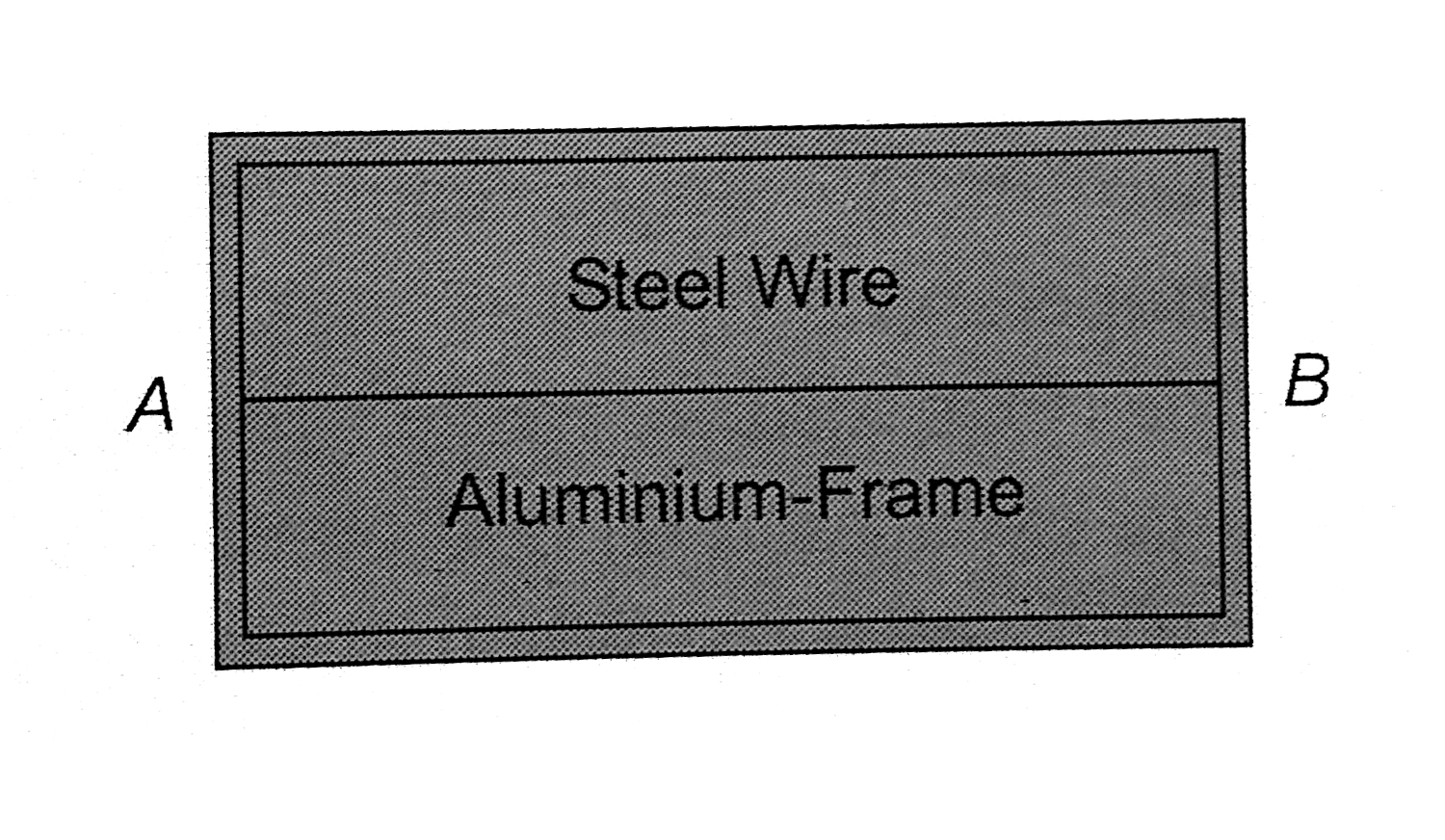A steel wire AB of length 85cm at 10∘C is fixed rigidly at points A and B in an aluminium frame as shown. If the temperature of the system is raised to 110∘C , what extra stress will be produced in the wire relative to aluminium frame. Assume that coefficient of linear expansion for aluminium and steel are 23×10−6/∘C and 11×10−6/∘C respectively and Young's moduls for steel is 2×1011 pa.

As αa>αs , on heating, aluminium frame will expand more than the steel wire
Thermal strain in steel wire realtive to aluminium wire
=(αa−αs)Δθ
=(23−11)×10−6×[110−10]
=1.2×10−3
Thermal stress=Y ×Thermal strain
=2×1011×1.2×10−3
=2.4×108N/m2 .
Topper's Solved these Questions
- TEMPERATURE AND THERMAL EXPANSIONBook:CP SINGHChapter:TEMPERATURE AND THERMAL EXPANSIONExercise:EXERCISES
Explore 64 Videos
- SOUND WAVESBook:CP SINGHChapter:SOUND WAVESExercise:Exercises
Explore 130 Videos
- UNITS, DIMENIONS AND MEASUREMENTSBook:CP SINGHChapter:UNITS, DIMENIONS AND MEASUREMENTSExercise:Exercises
Explore 63 Videos
Similar Questions
What should be the sum of lengths of an aluminium and steel rod at 0∘C is, so that all the temperature their difference in length is 0.25m. (Take coefficient of linear expansion for aluminium and steel at 0∘C as 22×10−6/.∘C and 11×10−5/.∘C respectively.)
View SolutionAn iron rod of length 50cm is joined at an end to an aluminium rod of length 100cm . All measurements refer to 20∘C . Find the length of the composite system at 100∘C and its average coefficient of linear expansion. The coefficient of linear expansion of iron and aluminium are 12×10−6/∘C and 24×10−6/∘C respectively.
View Solution
Knowledge Check
A steel wire AB of length 100cm is fixed rigidly at points A and B in an aluminium frame as shown in the figure. If the temperature of the system increases through 100∘C, then the excess stress produced in the steel wire relative to the aluminium?
αAl=22×10−6/0C and αsteel=11×10−6/0C
young's Modulus of steel is 2×1011Nm−2.
_E01_116_Q01.png) A2.2×108PaB22×108PaC0.2×108PaD220×108Pa
A2.2×108PaB22×108PaC0.2×108PaD220×108PaA steel scale is correct at 0∘C. The length of a brass tube measured by it at 40∘C is 4.5 m. The correct length of the tube at 0∘C is (Coefficients of linear expansion of steel and brass are 11×10−6/∘Cand19×10−6/∘C respectively.)
A4.001mB5.001mC4.999mD4.501mA steel wire of length 20 cm and uniform cross-sectional area of 1mm2 is tied rigidly at both the ends at 45∘C. If the temperature of the wire is decreased to 20∘C, then the change in the tension of the wire will be
[Y for steel =2×1011Nm−2, the coefficient of linear expansion for steel =1.1×10−5/∘C−1]A22 NB32 NC55 ND60 N
An iron rod of length 50cm is joined at an end to an aluminium rod of length 100cm . All measurements refer to 20∘C . Find the length of the composite system at 100∘C and its average coefficient of linear expansion. The coefficient of linear expansion of iron and aluminium are 12×10−6/∘C and 24×10−6/∘C respectively.
View SolutionFind the ratio of the lengths of an iron rod and an aluminium rod for which the difference in the lengths in independent of temperature. Coefficients of linear expansion of iron and aluminium are 12×10−60C^(−1)and23×10−60C(−1)respectively.
View SolutionA thin brass sheet at 20∘C and a thin steel sheet at 30∘C have the same surface area. The common tempreture at which both would have the same area is (Coefficient of linear expansion for brass and steel are respectively, 19×10−6/∘C are 11×10−6/∘C)
View SolutionA steel wire 2 mm in diameter is just stretched between two fixed points at a temperature of 20∘C. If the temperature falls to 10∘C, then the tension in the wire is (The coefficient of linear expansion of steel = 11×10−6/∘C and Y for steel 2.1×1011N/m2)
View SolutionA steel wire 2 mm is diameter is just stretched between two fixed points at a temperature of 20∘C. If the temperature falls to 10∘C, then the tension in the wire is (Coefficient of linear expansion of steel (α) is 11×10−6/∘CandYs=2.1×1011N/m2)
View Solution
